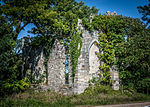Wye House
Archaeological sites on the National Register of Historic Places in MarylandFrederick DouglassHistoric American Buildings Survey in MarylandHouses completed in 1781Houses in Talbot County, Maryland ... and 8 more
Houses on the National Register of Historic Places in MarylandLloyd family of MarylandNational Historic Landmarks in MarylandNational Register of Historic Places in Talbot County, MarylandPlantation houses in MarylandUse mdy dates from August 2023Welsh-American culture in MarylandWelsh-American history

Wye House is a historic residence and former headquarters of a historic plantation house northwest of Easton in rural Talbot County, Maryland. Built in 1781–1784, it is a high-quality and well-proportioned example of a wooden-frame Southern plantation house. It was designated a National Historic Landmark in 1970.
Excerpt from the Wikipedia article Wye House (License: CC BY-SA 3.0, Authors, Images).Wye House
Bruffs Island Road, Easton
Geographical coordinates (GPS) Address External links Nearby Places Show on map
Geographical coordinates (GPS)
| Latitude | Longitude |
|---|---|
| N 38.853398 ° | E -76.168406 ° |
Address
Wye House
Bruffs Island Road
Easton
Maryland, United States
Open on Google Maps


